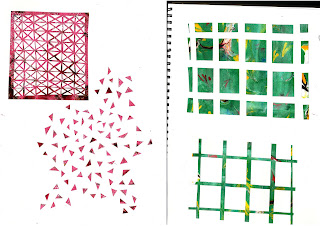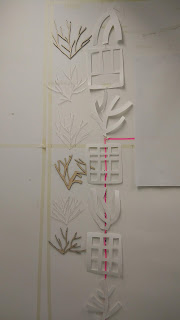Over Easter we all explored our theme, architecture, through
our chosen endangered craft. My focus was on marbling, so I used my
photographic documentation of architecture around Manchester to inspire
drawings and mark making. I struggled at first to incorporate architecture and
marbling, but started to investigate the two though paper cutting.
 |
| Combining paper cutting and marbling. |
I tried different methods of marbling, using turpentine,
water and oil paint, shaving foam and food colouring and carrageenan and alum.
I found that the quickest method was using oil paint and turpentine, but the carrageenan
method provided the best solution for creating my own designs. Shaving foam
gave a less consistent, faded and smudged effect. I then used the marbled
papers for paper cutting, to draw from my architectural photos with a scalpel.
I enjoyed this method, as it helped me to focus on shapes and details, and the
swirled patterns of the papers represented a lot of the detailed facades found
in architecture. I also marbled onto wood and fabric to see how I could apply
marbling to more tactile surfaces. Oil paint marbling worked especially well on
wood, while carrageenan marbling was best for fabric, especially silk.
 |
| Marbling with carageenan. |
 |
| Marbling with oil paint and turpentine. |
 |
| Marbling with shaving foam. |
After Easter, we got back together as a group and collated
what we had all done. We found that we had all been working quite separately,
despite being inspired by the same theme. I think this was because our chosen
crafts were so different, and because we all came from very distinct
specialisms.
We instantly started thinking of ideas for a final piece,
however following our tutorial soon after the holiday, we realised that we
needed to focus on working together and sampling, and not fixate on the final
outcome. Rather, by pooling our ideas we hoped to think through making.
 |
| Ceramics workshop. |
 |
| Working together in the paper folding workshop. |
We began with each member of the group running a workshop to
teach the others their endangered craft. This was a brilliant way to produce
samples, as we all brought things we had been working on individually and
incorporated them into the new skill. For example, the first session we had was
a paper model building workshop, where we all made 3D structures. Then we
brought those to the next session, which I ran on marbling, and dipped our
forms into the inks to add pattern, colour and texture.
We then had workshops on rag-rugging, using concrete, calligraphy,
weaving and ceramics. I loved learning all the new skills, and felt really
lucky to be able to use areas of the art school such as the ceramics studio
which I wouldn’t have had the opportunity to do otherwise.
 |
| Ceramic samples. |
 |
| Ceramics workshop. |
 |
| Rag-rugging workshop. |
 |
| Creating concrete blocks in the concrete workshop. |
 |
| Marbling workshop. |
 |
| Paper folding workshop. |
 |
| Calligraphy workshop. |
 |
| Weaving onto marbled perspex in the weave workshop. |
We decided to film each session and create time-lapse videos
as a way of recording the experience along with the samples themselves, to give
a detailed visual documentation. In a way, the videos act as samples in
themselves, as the collaborative element is probably the most important part of
the whole project, and this way we could capture that.
The workshops have transformed how we have worked as a group
and thought about the project in general. We were more productive when sharing each
other’s skills, and I certainly found that having people to constantly talk to
and test ideas with made me more confident in taking risks. Spending such a lot
of time together was inspiring and helped us to work though problems when they arose
such as how create moulds for concrete pillars.
 |
| Moulds created to make concrete pillars. |
I tend to become introspective when working on my individual
projects, so I have found the workshops hugely beneficial in terms of not being
anxious to try new things. I also find that I can be really disheartened when
things don’t go to plan, but being in a group has helped me see past ‘failures’
and either re-purpose them or accept them and move on. For example, I planned
to laser cut some triangles out of marbled wood, however didn’t anticipate that
the marbling would affect the surface of the wood, meaning it burned, as well
as not cutting out the shapes properly. Usually, I would feel particularly
upset about this but being in a group allowed me to see it as part of the
process of sampling. Instead, we decided to drill holes into wood and Perspex and
stitch into them.
 |
| 'Failed' laser cut piece. |
Overall, despite feeling a bit stuck at the start, by
embracing the idea of collaboration we have had a successful fortnight of
sampling and cooperating by sharing our skills. This has also taught us not to
be too precious about our samples, and forced us to pass them on for someone
else to add their expertise to. At this point, I am now leaving the group to go
on placement at Rob Ryan Studio in London which specialises in paper cutting. However, we will continue to communicate as a group over Whatsapp, and brainstorm ideas for our final selection of samples for the exhibition. Our next step will be to consider which samples should be included in the exhibition and how they will be displayed. Influenced by our theme of architecture, we have thought about displying our samples as a kind of metropolis/architectural plan for a city. This has been inspired by the work of the artist Beth Stafford, a ceramicist whose brutalist-inspired pieces resemble buildings.
I
am really looking forward to working with paper cutting in a professional setting
but will hugely miss working with my Unit X group and the daily workshops as it
has been one of the most valuable group projects I have been involved with.























Comments
Post a Comment